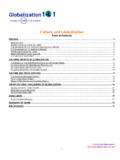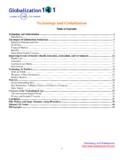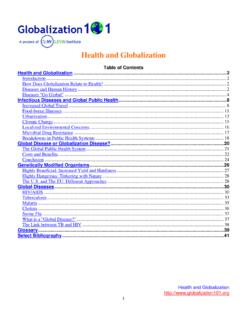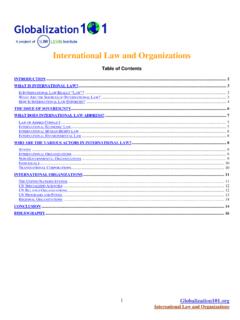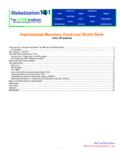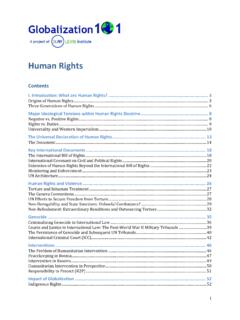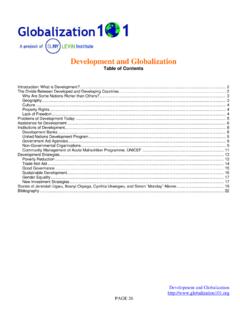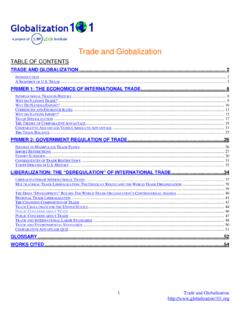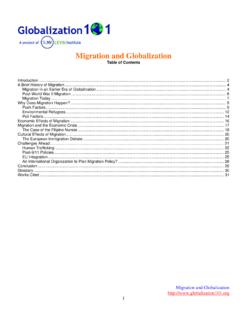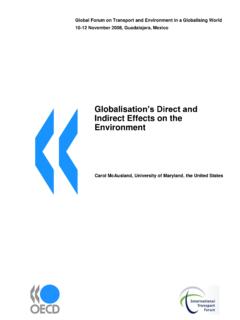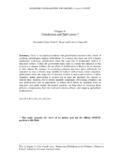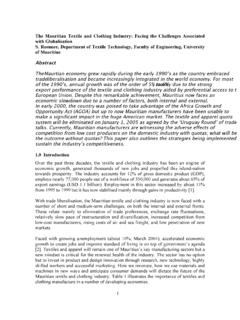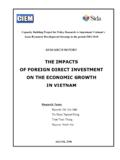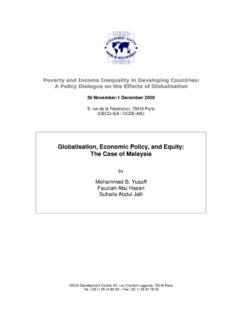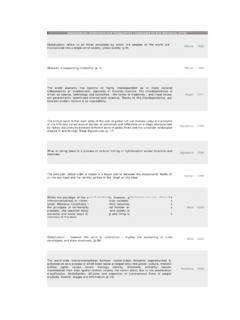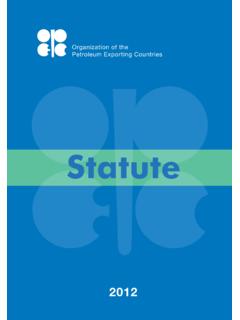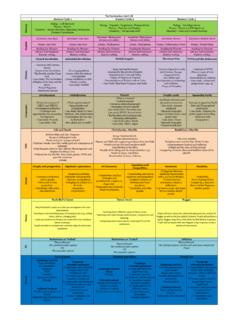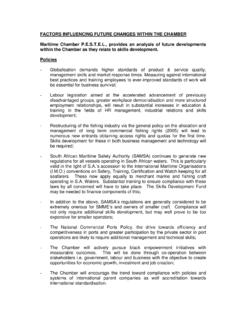Transcription of Migration and Globalization - globalization | globalisation
1 Migration and Globalization 1 Migration and Globalization Table of Contents Introduction .. 2 A Brief History of Migration .. 4 Migration in an Earlier Era of Globalization .. 4 Post-World War II Migration .. 6 Migration Today .. 7 Why Does Migration Happen? .. 9 Push 9 Environmental Refugees .. 12 Pull Factors .. 14 Economic Effects of Migration .. 16 Migration and the Economic Crisis .. 17 The Case of the Filipino Nurses .. 18 Cultural Effects of Migration .. 20 The European Immigration Debate .. 20 Challenges Ahead .. 21 Human Trafficking .. 22 Post-9/11 Policies .. 25 EU Integration .. 25 An International Organization to Plan Migration Policy? .. 28 Conclusion .. 29 Glossary .. 30 Works Cited .. 31 Migration and Globalization 2 Introduction Transnational flows of goods and capital have driven Globalization during recent years. These flows have been made possible by the gradual lowering of barriers to trade and investment across national borders, thus allowing for the expansion of the global economy.
2 However, states have often firmly resisted applying similar deregulatory policies to the international movement of people. As noted by the World Bank in its report, Globalization , Growth, and Poverty, while countries have sought to promote integrated markets through liberalization of trade and investment, they have largely opposed liberalizing Migration policies. Many countries maintain extensive legal barriers to prevent foreigners seeking work or residency from entering their national borders. In fact, immigration policies across the world are becoming stricter as governments attempt to minimize the economic, cultural, and security impacts of large movements of people between nations. Despite the reluctance of governments to liberalize immigration policy, however, the number of people living outside their countries of origin has risen from 120 million in 1990 to an estimated 215 million in 2012 (The World Bank, 2012), which is approximately percent of the world population.
3 A 2009 study conducted by Gallup Polls across 135 countries reveals that 16 percent of the world s adult population would like to move permanently to another country if they had the chance. However, these numbers seem to vary by region. According to polls taken from 2007 - 2009, 38 percent of sub-Saharan Africans want to migrate, while only 10 percent of Asians want to permanently leave their home country. The is the most desirable destination country, according to those polls (Espisova, Ray, 2009). A variety of reasons lie behind Migration . People may migrate in order to improve their economic situation, or to escape civil strife, persecution, and environmental disasters. Traditionally, the reasons encouraging an individual to migrate were categorized as "push" or "pull" factors. Globalization has introduced a third set of motivations called "network" factors, which include free flow of information, improved global communication and faster and lower cost transportation.
4 While network factors are not a direct cause of Migration , they do facilitate it. As well as encouraging Migration , Globalization also produces countervailing forces. For example, as businesses grow and become more internationalized they often outsource their production to developing countries where labor costs are lower. This movement of jobs from developed nations to the developing world mitigates certain economic factors leading to Migration . In other words, in a global economy jobs can move to potential migrants instead of migrants moving to potential jobs. The impacts of Migration are complex, bringing both benefits and disadvantages. Immigration provides a supply of low cost labor for host countries, while remittances from emigrant workers can be an important source of foreign income for sending nations. On the other hand, immigration can stoke resentment and fear towards newcomers in receiving states, as immigrants are discriminated against, accused of lowering wages and associated with crime, among other complaints.
5 For the economies of sending nations, emigration leads to a loss of young, able-bodied, well-educated and otherwise economically valuable citizens. This Issue in Depth is designed to help you understand the causes of Migration , the allocation of benefits, and the ways in which individual countries and the international community deal with this important subject. The Issue in Depth addresses primarily voluntary economic Migration , that is, migrants who relocate to a foreign country as temporary workers or legal Today, the number of people living outside their country of birth is larger than at any other time in history. International migrants would now constitute the world's fifth most populous country if they all lived in the same place (UNFPA). Migration and Globalization 3 immigrants. These categories of migrants are perhaps the most controversial as governments struggle to create a Migration policy that effectively acknowledges economic necessity and domestic apprehensions.
6 Civil conflict and oppression create different patterns of Migration in the form of refugees and asylum seekers. These types of Migration , however, are not causally related to Globalization and are only briefly discussed below. Migration and Globalization 4 A Brief History of Migration Migration in an Earlier Era of Globalization The most recent era of mass voluntary Migration was between 1850 and 1914. ver one million people a year were drawn to the new world by the turn of the 20th century. A World Bank report, International Migration and the Global Economic Order, estimates that 10 percent of the world's population was migrating in this time period, whereas Migration today is around three percent. Growing prosperity, falling transport costs relative to wages, and lower risk all helped to facilitate this era of mass Migration . (A situation not unlike that of today) It was also at this earlier time that states developed a formal and regulated system of passports and visas to control the flow of people across national borders.
7 The effects of the first era of Migration can be seen in the population compositions of many countries in the Western Hemisphere. In the latter part of the 19th century, for example, nearly 15 percent of the population was foreign born, with the overwhelming majority of these immigrants arriving from Europe. Irish and Italian immigrants came in particularly large numbers, as did Russian and East European Jews, Czechs, Slovaks, Poles, and Germans. Most current citizens of European decent are a product of this period of immigration (O Rourke, 2001). At the same time that European emigration was surging during the 19th Century, Chinese and Japanese immigrants were arriving in large numbers to the West Coast of the and Hawaii (Richin, 1972). However, streams of Asian immigration to the were quickly halted by a series of restrictive policies targeting Chinese, Japanese and finally all Asian immigrants at the turn of the 20th Century (Daniels 1999).
8 Elsewhere in the Western Hemisphere, rapidly developing countries such as Argentina, Brazil, and Chile experienced large influxes of Spanish and Portuguese immigrants facilitated by the past colonial connection between their countries, but also received immigrants from Germany, Britain, Italy, Poland, China, and Japan (O Rourke, 2001). This wave of immigration to the New World resulted in moments of backlash against immigrants. In the , immigrants were blamed for crime, disease, and the persistence of poverty in the urban centers of the Northeast and Midwest. Furthermore, immigrants formed a large and restless population that seemed ripe for social conflict. Groups calling for worldwide socialist revolution found adherents among poor immigrants, and immigrants were also prominent members and leaders of labor unions, which were often viewed as potential sources of foreign, socialist opposition to American capitalism. In 1919 and 1920, Attorney General A.
9 Mitchell Palmer instigated numerous roundups of immigrants during the "Palmer's Raids," which led to the deportation of thousands of supposed Communist agitators (Daniels 2002). At the same time, Asian immigrants were viewed with suspicion and outright racism on the West Coast. In 1878, the Supreme Court ruled that Chinese immigrants were prohibited from becoming naturalized American citizens. In 1882, the Congress passed the Chinese Exclusion Act preventing Chinese laborers from coming to the for ten years; later the act was amended to prohibit virtually all Chinese immigration, a situation that lasted until the mid-1900s. Similarly, Japanese immigration was restricted by the 1907 Gentleman's Agreement between the governments of Japan and the Ultimately, nearly all Asian immigration was banned by the Asiatic Barred Zone provision of the Immigration Act of 1917 (Daniels 2002). By 1924, undesirable European Migration from Southern and Eastern Europe was also severely diminished through the implementation of a new quota system that strictly limited yearly entrants per migrant-sending country.
10 Again, this legislation resulted largely from nativist, anti-immigrant sentiments which rose in response to historic levels of immigration. Curiously, the Western Hemisphere wasn t subject to the 1924 quotas, allowing Latin American immigrants to fill the labor demand previously met by European and Asian immigrants (Daniels 2002). These developments and the global depression of the 1930s significantly reduced Migration to the Western Hemisphere. Even as World War II and the Holocaust were on the horizon, Jews trying to get out of Germany and Austria were refused entry to other countries. At the 1938 Evian Conference in France, delegates from dozens of countries declined to increase Migration and Globalization 5 quota numbers to admit the Jews fleeing persecution, with only one, the Dominican Republic, offering to take in any refugees (Laffer, 2011). Migration and Globalization 6 Post-World War II Migration As the countries of Europe recovered from World War II, they again became attractive destinations for potential migrants and opened their doors to immigrants to help rebuild their economies.
